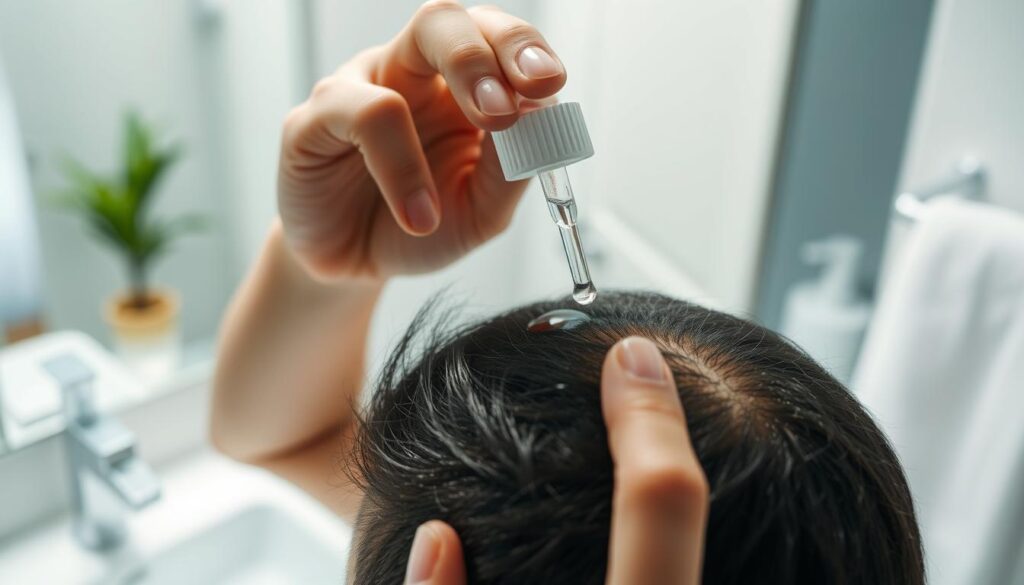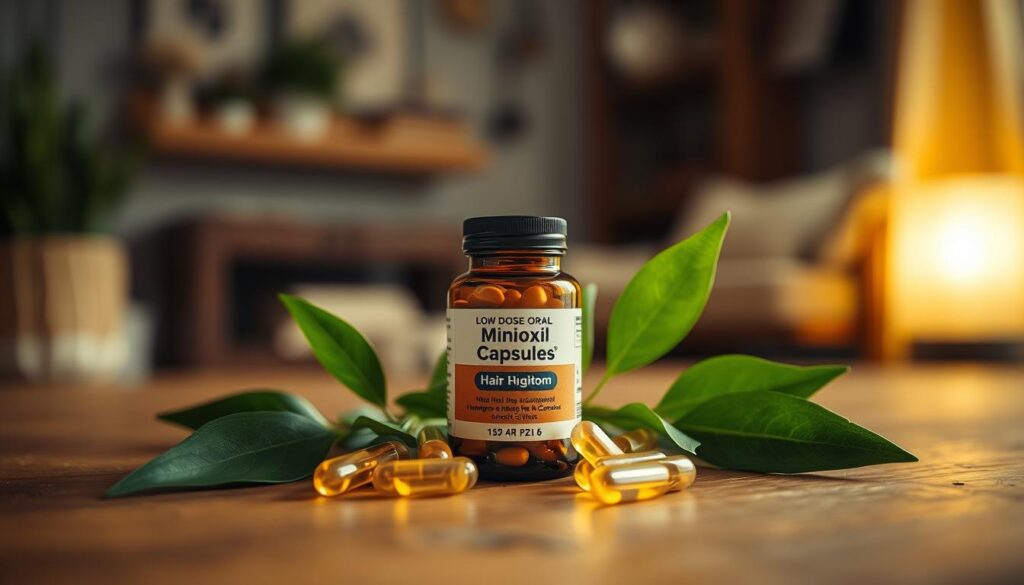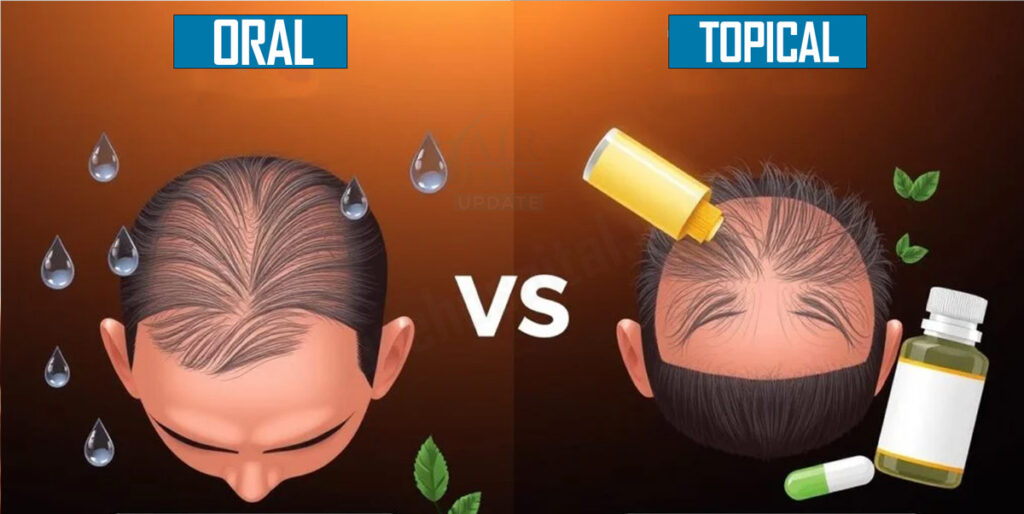Contents
Discover the efficacy of oral vs topical minoxidil for hair loss. Explore which option is safer and more effective in treating hair thinning.
Have you ever thought about if a pill could help you get more hair? I’ve wondered this a lot, especially when my hair started to thin. Now, I hear more about oral minoxidil for hair loss. But how does it compare to the topical version?
Minoxidil is a big deal in fighting hair loss. It comes as a liquid or foam for your scalp and as a pill. Both types aim to stop androgenetic alopecia, the most common hair loss type. But which one is better?
Studies have looked into this debate. A 24-week study compared oral and topical minoxidil for male pattern baldness. It found oral minoxidil slightly improved hair density on the crown. But, it didn’t beat the topical version overall.
Choosing between oral and topical minoxidil is tricky. It’s about what works best for you, considering ease, side effects, and how you react to it. Topical minoxidil has been a favorite for years. But, oral minoxidil is becoming more popular as an alternative.
We’ll look into the good and bad of each type. This will help you decide on your hair loss treatment. Whether you’re just starting to see thinning or want a new solution, knowing your options is crucial.
Short Summary
- Oral and topical minoxidil are both effective for treating hair loss
- Topical minoxidil has a longer track record and is FDA-approved
- Oral minoxidil may offer better compliance but has more systemic side effects
- The choice between forms depends on individual factors and medical history
- Combination therapies with minoxidil may enhance hair growth results
Understanding Minoxidil: A Hair Loss Treatment Revolution
Minoxidil has changed how we treat hair loss. I’ve seen it help many people feel confident again. Let’s look at how minoxidil works and its effects.
What is Minoxidil and How Does It Work?
Minoxidil is a strong medicine that helps hair grow. It makes blood flow better to hair roots. This makes hair thicker and stronger.
It also makes the hair growth cycle longer. This means hair looks fuller and healthier.
From Hypertension Treatment to Hair Loss Solution
At first, minoxidil was for high blood pressure. But it made hair grow too much. This led to using it for hair loss.

Stimulating Hair Follicles
We don’t know all about minoxidil, but it helps hair follicles a lot. It makes blood flow better to the scalp. This wakes up hair follicle cells.
This helps start the hair growth cycle again. It fights hair thinning in men and women.
“Minoxidil has shown remarkable efficacy in promoting hair growth, with up to 75% of patients experiencing enhanced global hair density.”
The story of minoxidil going from blood pressure medicine to hair loss treatment is interesting. Its success in growing hair has made it a key treatment. As we learn more, we might find even more ways it helps.
Topical Minoxidil: The Traditional Approach
Topical minoxidil 5% has changed the game for fighting hair loss. It’s a top choice for many dealing with thinning hair. This treatment has shown great results in making hair thicker.
Application Methods and Dosage
Using topical minoxidil is easy. Most people apply it twice a day on their scalp. Men usually use the 5% solution, while women start with 2%. It’s important to be consistent to see results.

Efficacy in Male and Female Pattern Hair Loss
Studies show great results for both men and women. For men, a year-long study found 84% of users saw good results with 5% minoxidil applied twice daily. Women also see promising results. These studies show it can greatly improve hair density.
| Gender | Concentration | Positive Results |
|---|---|---|
| Male | 5% | 84% |
| Female | 2% | Promising |
Potential Side Effects and Skin Reactions
Topical minoxidil is usually safe, but some may have mild side effects. Skin irritation is the most common issue. Some people may experience itching or contact dermatitis. These problems are often mild and go away with time. It’s safer than oral treatments because it only affects the scalp.
There’s also exciting research on WAY-316606. This could offer more options in the future.
Oral Minoxidil: The Emerging Alternative
I’ve seen more people using low-dose oral minoxidil for hair loss. This medicine is now more popular as an off-label treatment for thinning hair. It works differently than the usual minoxidil you put on your scalp, offering effects that help some people more.
People usually take 0.25 to 2.5 milligrams of oral minoxidil every day. Some studies look into even higher doses. This is much less than the 5 to 40 milligrams used for blood pressure.

A study caught my attention. After 6 months on a 5-milligram daily dose, hair counts at the top of the head went up by 19.23%. That’s a big improvement!
But, oral minoxidil isn’t without its downsides. Side effects can include:
- Excessive hair growth on the body
- Swelling in the feet
- Initial hair shedding
- Changes in heart rate or blood pressure
Higher doses make these side effects more likely. That’s why seeing a doctor is key when taking this medicine.
| Oral Minoxidil Dose | Common Use | Potential Benefits | Side Effect Risk |
|---|---|---|---|
| 0.25 – 2.5 mg | Hair Loss | Improved Hair Density | Lower |
| 5 – 40 mg | High Blood Pressure | Blood Pressure Control | Higher |
I’m excited to see where low-dose oral minoxidil will lead in hair loss treatment. It could be a game-changer for those who haven’t found success with other treatments.
Oral vs Topical Minoxidil for Hair Loss: A Comparative Analysis
I looked into studies on oral and topical minoxidil for hair loss. Both types help increase hair density, but they work differently. Let’s explore how well they work and how easy they are to use.
Effectiveness in Promoting Hair Growth
A 24-week study showed some interesting results. Oral minoxidil helped grow 23.4 hairs per cm² on the vertex area. Topical minoxidil added 5.5 hairs per cm² there. Both types helped the frontal area too.

Absorption and Metabolism Differences
Oral minoxidil goes straight into the bloodstream, giving quick and steady results. Topical minoxidil depends on skin absorption, which can change from person to person. This affects how well it works.
Patient Compliance and Ease of Use
How well patients stick to their treatment is key. Many prefer taking a pill daily over applying a solution twice a day. A study with 1,404 patients on low-dose oral minoxidil found few side effects. This could make it easier to stick with the treatment over time.
| Factor | Oral Minoxidil | Topical Minoxidil |
|---|---|---|
| Application | Once daily pill | Twice daily topical |
| Price Range | $30-$40 (generic) | $20-$70 |
| Availability | Prescription only | Over-the-counter |
Oral and topical minoxidil both boost hair density. But oral minoxidil might work better in some areas. Your choice should depend on what you prefer and what your doctor says.
Safety Profile: Weighing the Risks and Benefits
I looked into the safety of minoxidil. It’s key to know the risks and benefits. Minoxidil, whether taken by mouth or applied on the skin, can have side effects. Let’s look at these to help you decide wisely.
Common Side Effects of Oral and Topical Minoxidil
People using minoxidil on their skin might feel skin irritation, itchiness, or a burning feeling where they apply it. Sometimes, it can lead to temporary hair loss, more hair growth, or acne.
Oral minoxidil can affect your whole body. Side effects include:
- Dizziness
- Fluid retention
- Rapid heartbeat
- Headaches
- Excessive body hair growth (hypertrichosis)
Long-term Safety Considerations
Research says minoxidil is usually safe for long use. A study with 1,404 patients on low-dose oral minoxidil for at least 3 months showed most didn’t have bad side effects. But, it’s important to watch how your body reacts over time.
Precautions and Contraindications
Some people should not use minoxidil:
- Pregnant or breastfeeding women
- People with certain heart conditions
- Those with skin issues on the scalp
Always talk to a doctor before starting minoxidil. They can look at your health history and decide if it’s right for you. Remember, minoxidil can help with hair loss, but think about its safety first.
Choosing the Right Minoxidil Treatment for You
Choosing between oral and topical minoxidil depends on your situation. The best choice is based on a detailed hair loss check-up by a pro.
Your doctor will look at your hair loss severity, past treatment results, and possible side effects during a consultation. They’ll also consider your health history and lifestyle. This helps them find the best treatment for you.
Here’s a quick look at oral and topical minoxidil:
| Factor | Oral Minoxidil | Topical Minoxidil |
|---|---|---|
| Effectiveness | Slightly outperforms topical in some studies | 84% positive response rate in long-term study |
| Side Effects | Systemic (e.g., changes in heart rate) | Local (e.g., skin irritation) |
| Ease of Use | Simple pill form | Requires daily application to scalp |
Your treatment options go beyond minoxidil. Your doctor might suggest combining it with other treatments for better results. The goal is to find a solution that suits you and stick with it.
Conclusion
I looked into hair loss solutions and found both oral and topical minoxidil work well. Studies show they can help a lot. For example, 43% of men using 5mg oral minoxidil saw great hair growth.
When choosing a treatment, think about what’s best for you. Oral minoxidil is easy to use and can work with other treatments. But, it might cause more hair growth or headaches. Topical minoxidil is also effective but needs to be applied twice a day, which can be hard for some.
For the best hair growth, find a treatment that fits you. A study with 90 men showed 5mg oral minoxidil worked as well as 5% topical solution after six months. Your choice should match your needs, possible side effects, and your life. Remember, sticking with your treatment is key for the best results.
FAQ
What is minoxidil, and how does it work for hair loss?
Minoxidil was first made to treat high blood pressure. But, it also made hair grow. It does this by making more blood flow to hair roots and directly helping the cells that make hair.
It also makes the hair growth cycle longer and stronger. This helps stop hair from thinning due to genetics in both men and women.
What are the differences between topical and oral minoxidil?
Topical minoxidil is a product you put on your scalp yourself. It’s the first thing doctors suggest for hair loss. Oral minoxidil is a pill you take, in small amounts (usually 0.25 to 5 mg a day).
It gets broken down in the liver and spreads through your blood. This might make it more steady in reaching hair roots.
How effective are topical and oral minoxidil in promoting hair growth?
Both types of minoxidil help with hair loss. Studies show they make hair thicker and cut down on hair loss. Oral minoxidil might work a bit better for some women, but it varies.
How well it works depends on how your body handles the drug and if you use it as told.
What are the potential side effects of topical and oral minoxidil?
Topical minoxidil might cause skin irritation or itching where you apply it. Oral minoxidil could make you feel dizzy, swell up, have a fast heartbeat, headaches, or grow more hair in places you don’t want it.
Most people don’t have big problems with the low doses of oral minoxidil. But, it’s good to talk to a doctor about any risks or things you shouldn’t do.
How do I choose between oral and topical minoxidil for hair loss treatment?
Choosing between oral and topical minoxidil depends on how much hair you’ve lost, how you react to treatments, and what side effects you can handle. Talking to a skin doctor or hair loss expert is key.
They’ll look at your health, your life, and what you want to achieve. Then, they can suggest the best minoxidil type or a mix of treatments for you.
Source Links
- Oral Minoxidil vs Topical Minoxidil for Male Androgenetic Alopecia – https://jamanetwork.com/journals/jamadermatology/fullarticle/2817326
- Should you use oral minoxidil instead of topical minoxidil? – https://www.hairdr.com/hairlines/should-you-use-oral-minoxidil-instead-of-topical-minoxidil/
- Minoxidil for Women: Oral versus Topical Minoxidil – https://www.meditresse.com/blog/minoxidil-for-women-oral-versus-topical-minoxidil/
- Is this the Golden Age of Hair Loss Treatment? – Modern Aesthetics – https://modernaesthetics.com/articles/2024-mar-apr/is-this-the-golden-age-of-hair-loss-treatment-1
- Nanoxidil vs. Minoxidil: Which Hair Loss Treatment is Right for You? – https://www.clinikally.com/blogs/news/nanoxidil-vs-minoxidil-which-hair-loss-treatment-is-right-for-you?srsltid=AfmBOor5_zDJt79Pf6e0JfwWJ_pcn3-Kc2VrDf_77fh_kOluG_PERh5z
- Oral Minoxidil for Hair Loss, Treatment for Hair Loss & Balding – https://www.michelegreenmd.com/oral-minoxidil-hair-loss
- Topical Minoxidil vs. Finasteride for Hair Loss – Dr. Michele Green M.D. – https://www.michelegreenmd.com/topical-minoxidil-vs-finasteride-for-hair-loss
- Foam vs. Liquid vs. Oral Minoxidil – HairScience – https://hairscience.org/news/foam-liquid-and-oral-minoxidil/
- Role of Oral Minoxidil in Patterned Hair Loss – https://www.ncbi.nlm.nih.gov/pmc/articles/PMC9650732/
- Oral Minoxidil vs Topical Minoxidil for Male Androgenetic Alopecia: A Randomized Clinical Trial – PubMed – https://pubmed.ncbi.nlm.nih.gov/38598226/
- Oral vs topical minoxidil: What is best for hair loss? – https://miiskin.com/hair-loss/medications-for-hair-loss/oral-vs-topical-minoxidil/
- Efficacy and Safety of Oral Minoxidil 5 mg Once Daily in the Treatment of Male Patients with Androgenetic Alopecia: An Open-Label and Global Photographic Assessment – https://www.ncbi.nlm.nih.gov/pmc/articles/PMC7649170/
- Wimpole Hair Transplant Clinic – https://wimpoleclinic.com/blog/oral-minoxidil-for-hair-loss-uses-dosage-results-side-effects/
- Topical Minoxidil for Hair Loss: What Are the Side Effects? – https://www.aol.com/side-effects-topical-minoxidil-hair-125700799.html
- What is the Best Treatment for Alopecia | PRP Treatment – https://prptreatmentbeverlyhills.com/what-is-the-best-treatment-for-alopecia/
- Oral Minoxidil vs Topical – https://xyonhealth.com/blogs/library/oral-minoxidil-vs-topical?srsltid=AfmBOoqdtR35HLkPHz3DLLtMPTuBdgTxshWWAMq8dVBRLOLLVTaTyTSx
- Oral Minoxidil v Topical: What’s the difference? – https://sons.co.uk/blogs/journal/oral-minoxidil-v-topical-whats-the-difference
- Oral Minoxidil- What You Need To Know – Hair Transplant Specialists – Treatment Rooms London – https://www.treatmentroomslondon.com/hair-loss/oral-minoxidil-what-you-need-to-know/
- Oral Minoxidil for Hair Loss: Efficacy, Dose, and Side Effects – ISHRS – https://ishrs.org/oral-minoxidil-for-hair-loss/
- A Comprehensive Comparison for H – https://scandinavianbiolabs.com/blogs/journal/oral-minoxidil-vs-topical
- Head-to-Head Analysis of Topical vs. Oral Minoxidil for Male Pattern Baldness | EBSCO – https://www.ebsco.com/clinical-decisions/dynamed-solutions/about/ebm-focus/head-head-analysis-topical-vs-oral-minoxidil
